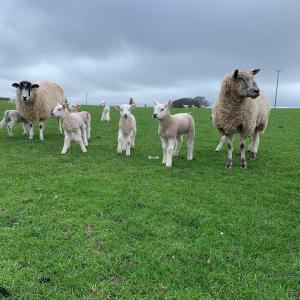
By Vet Bruce Richards BVSc DBR MRCVS
Chlamydiosis is one of the most common causes of infectious reproductive loss and abortion in sheep flocks and its control and prevention is important for maintaining health and productivity. Enzootic Abortion of ewes (EAE) or Chlamydia, is a bacterial infection by Chlamydophila abortus, primarily causing reproductive problems but also pneumonia and other health issues. The outcome of infection is determined by the timing of infection, the immunity of the animal infected and the numbers of organisms taken in. Infection with the Chlamydophila organism, originating from birth fluids and placentas of recently or latently infected sheep, results in huge multiplication and shedding in birth fluids and placenta at subsequent lambing.

Some strategies for control include:
1. Vaccination: One of the most effective ways to control chlamydia in sheep is through vaccination. There are several live vaccines available that can protect sheep against chlamydia. These vaccines should be given to ewes prior to breeding, as well as to lambs and young sheep. Vaccination is most effective when used in combination with other control measures, such as good hygiene and biosecurity practices.
2. Good hygiene: The main source of infection is infected sheep shedding at lambing time in birth fluids either from newly infected sheep or recovered carrier sheep that aborted during a previous pregnancy so good hygiene practices are essential for controlling chlamydia in sheep. This includes cleaning and disinfecting equipment and facilities, as well as practicing good personal hygiene when handling sheep. Regular cleaning of lambing pens, feeders, and water troughs can help prevent the spread of the disease. Any foetal or aborted material should be immediately removed. It is also important to quarantine new animals before introducing them into the flock.
3. Biosecurity: Biosecurity measures can help prevent the introduction and spread of chlamydia in sheep flocks. Introducing a latently infected sheep is the most common source of initial infection resulting in a small number of abortions in the first year and an abortion storm in the subsequent year. This includes limiting access to the flock, as well as monitoring and controlling the movement of animals in and out of the farm. It is also important to ensure that visitors to the farm follow biosecurity protocols, such as wearing clean clothing and footwear, and using disinfectant footbaths.
4. Testing and monitoring: Regular testing and monitoring of sheep flocks can help detect chlamydia early and prevent its spread. This includes monitoring for signs of disease, such as respiratory symptoms or reproductive problems. Blood tests can also be used to detect the presence of chlamydia antibodies in the flock. Testing should be done regularly, especially in high-risk areas or during times of stress, such as during or after lambing where testing can be targeted on aborted or barren ewes.
5. Antibiotic treatment: Antibiotics can be used to treat chlamydia infections in sheep. However, antibiotic resistance is a growing concern in both human and animal health, and the use of antibiotics should be minimized whenever possible. Antibiotics should only be used under the guidance of a veterinarian, and only when necessary to treat a confirmed chlamydia infection.
In conclusion, controlling chlamydia in sheep requires a multifaceted approach that includes vaccination, good hygiene, biosecurity measures, testing and monitoring and where appropriate, antibiotic treatment. By implementing these strategies, sheep farmers can help prevent the spread of chlamydia and protect the health and productivity of their flocks. It is important to work closely with a veterinarian to develop a comprehensive chlamydia control program that is tailored to the specific needs of your farm.